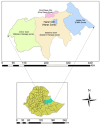Compliance and associated factors of personal protective equipment among sanitary workers in selected public hospitals, Eastern Ethiopia: A cross-sectional study design
- PMID: 39713265
- PMCID: PMC11663277
- DOI: 10.1177/20503121241308303
Compliance and associated factors of personal protective equipment among sanitary workers in selected public hospitals, Eastern Ethiopia: A cross-sectional study design
Abstract
Background: Adherence to the proper use of protective personal equipment (PPE) in health care facilities including public hospitals is challenging among sanitation workers(SWs) across the world in general and in developing countries in particular. Despite the emphasis inline up on various policies and guidelines for PPE use implementation, inconsistent use of PPE, disobedience to PPE regulations, negligence, ignorance, discomfort, and lacking infection prevention and control (IPC) practice have been identified as main associated factors. All these and other factors contributing for the non-compliance of PPE practice among SWs within the hospitals in nations with limited resources such as Ethiopia, as well as study regions. Thus, such non-adherence or improper application of PPE is a major concern, and ultimately the consequences of unworthy PPE use has had an influence on the health and safety of sanitary workers.
Objective: The aim of this study was to assess compliance and associated factors of personal protective equipment among sanitary workers in selected public hospitals, eastern Ethiopia.
Methods: A cross-sectional research design used with mixed of quantitative and qualitative data. Surveys were conducted on 809 hospital sanitary workers from May-to-August, 2023. Face-to-face interview was conducted for the quantitative data. Sixteen Key Informant interviews were participated. Field observation also conducted. Epi Data version 3.1 was used for data import, while Stata version 17 MP was used for analysis. Multilevel binary and multivariable regression were for the crude odds ratio and adjusted odds ratio. Variables were analyzed at four levels: Model-0, Model-1, Model-2, and Model-3 for outcome, individual level, hospital level, and individual and hospital levels, respectively. Of these, only model 3 was reported for the interpretation. The cut-point of p-value for crude odds ratio and adjusted odds ratio at model 3 were 0.20 and 0.05, respectively, with a 95% confidence interval reported.
Result: Out of 809 sanitary workers, 729 (90.11%) of them were responded. The prevalence of compliance and noncompliance with protective personal equipment practice among sanitary workers were 46.78(95% CI: 43.11%-50.47%) and 53.22% (95% CI: 50.19%-57.11%), respectively. Multivariable multilevel analysis of model 3 shows that the overall variation for compliance of protective personal equipment practice between sanitary workers from hospitals to hospitals was 26.66%. The model also found that those had daily supervision (AOR = 13.71, 3.18-59.11), good infection prevention and control practice (AOR = 11.34, 1.97-65.24), and perceived less severity of protective personal equipment (AOR = 1.46, 0.85-2.59) were more likely to increase protective personal equipment practice.
Conclusion: The study concluded that improper personal protective equipment practices among sanitary workers were caused by a shortage, discomfortable, wearing carelessly and negligence, felt less advantaged, and cues to action, and had worse self-efficacy. The study advised that maintaining a sufficient supply of protective personal equipment, increasing awareness of protective personal equipment utilization, and providing daily supervision are all necessary to improve the level of protective personal equipment compliance within the selected hospitals.
Keywords: Associated factors; compliance; personal protective equipment; public hospital; sanitary workers.
© The Author(s) 2024.
Conflict of interest statement
The author(s) declared no potential conflicts of interest with respect to the research, authorship, and/or publication of this article.
Figures
Similar articles
-
Compliance and determinants of infection prevention and control practices among sanitary workers in public hospitals, Eastern Ethiopia: A cross-sectional study.Health Sci Rep. 2024 Aug 23;7(8):e2318. doi: 10.1002/hsr2.2318. eCollection 2024 Aug. Health Sci Rep. 2024. PMID: 39184854 Free PMC article.
-
Occupational injuries and associated factors among sanitary workers in public hospitals, eastern Ethiopia: A modified Poisson regression model analysis.PLoS One. 2024 Nov 15;19(11):e0310970. doi: 10.1371/journal.pone.0310970. eCollection 2024. PLoS One. 2024. PMID: 39546541 Free PMC article.
-
Magnitude and associated factors of occupational hazard exposures among sanitary workers: Propose RASM model for risk mitigation for the public hospitals, eastern Ethiopia.BMC Res Notes. 2024 Jun 20;17(1):172. doi: 10.1186/s13104-024-06828-2. BMC Res Notes. 2024. PMID: 38902762 Free PMC article.
-
Barriers and facilitators to healthcare workers' adherence with infection prevention and control (IPC) guidelines for respiratory infectious diseases: a rapid qualitative evidence synthesis.Cochrane Database Syst Rev. 2020 Apr 21;4(4):CD013582. doi: 10.1002/14651858.CD013582. Cochrane Database Syst Rev. 2020. PMID: 32315451 Free PMC article.
-
Personal protective equipment for preventing highly infectious diseases due to exposure to contaminated body fluids in healthcare staff.Cochrane Database Syst Rev. 2020 May 15;5(5):CD011621. doi: 10.1002/14651858.CD011621.pub5. Cochrane Database Syst Rev. 2020. PMID: 32412096 Free PMC article.
References
-
- Goniewicz M, Włoszczak-Szubzda A, Niemcewicz M, et al. Review injuries caused by sharp instruments among healthcare workers—international and polish perspectives. Ann Agric Environ Med 2012; 19(3): 523–527. - PubMed
-
- Wall JM. Development of a health-belief-model-based instrument to assess worker beliefs about using personal protective equipment. Salt Lake City, UT: University of Utah. https://collections.lib.utah.edu/dl_files/79/75/7975a212671a985440474329... (2009; accessed June 2023).
-
- World Health Organizations/WHO. WHO guidelines on core components of IPC programs at the national and acute health care facility level, http://www.who.int/infection-prevention/publications/core-com-ponents/en/ (2016; accessed 13 April 2022). - PubMed
-
- EHS/Environmental Health and Safety. Guidelines for personal protective equipment (PPE). NIOSHA. Center for Disease Control and Prevention: National Institute of Occupational Safety and Health Association, 2020, pp. 3–40. https://www.cdc.gov/niosh/docs/2024-107/pdfs/2024-107.pdf
-
- Roseline S, Rachael UA, Orji NP. The use of personal protective equipment (PPE) among workers of five refuse disposal Nigeria. Asian J Appl Sci 2013; 01(05): 170–171.
LinkOut - more resources
Full Text Sources



